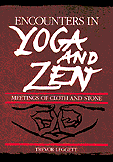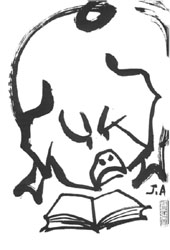|
..the phrase about pearls before swine came up in one of our
discussions on the Japanese radio: 'Give not what is holy to dogs, nor
cast your pearls before swine; lest they trample them under their feet and
turn again and rend you.' Like many Buddhist priests, he knew the Gospels,
and he said: 'Yes, they trample the pearls, but why do they turn and rend
you?' I never heard any Christian speak of this, so I improvised: 'It
shows the mindless spite towards what they feel is superior but cannot
understand.'
He said: 'Not at all. The pigs cannot understand that the pearls are superior.
You are blaming the pigs, but Christ is blaming the man who throws pearls
to them. Naturally they think it is food and try to eat it, but find it
is pebbles. So of course they are angry and want to bite him. It is no fault
in the pigs. Don't throw pearls to swine: it is not fair on the swine.'
|
Chains
A man said to his yoga teacher: 'I have tried to break my habit of going
to wine-shops and brothels, but I can't do it. I am in chains to my nature.
You can't expect a man in chains to do anything.
The teacher met him going to the town one evening. He was smartly dressed
and walking briskly in anticipation.
The teacher said: 'You don't look like a man in chains.'
|
Synopsis
The book of 108 pages contains fifty incidents showing applications of Yoga
and Zen in life. Half are from the Indian tradition and half from the Japanese.
There are tales from long ago, preserved orally or in temple magazines and
so on; others are modern, some of them observed or participated in by the
author. |
Reviews
REVIEW COMMISSIONED BY ASAHI EVENING NEWS, JAPAN.
It is not, I think, necessary to have a knowledge of or even interest in,
either yoga or Zen to find pleasure and learning in this book. Unlike much
that has been written on these subjects, the text is unpretentious, easy
to read, and for the most part hugely enjoyable....The aim of such stories
is to help a serious student to find realization and inspiration in everyday
life. As the book jacket puts it:
'Just as flint and steel are used to make fire, so these stories can be
used to create sparks within the reader's mind, which can, with care and
attention, be nurtured into the strong light of realization.'
Care and attention are qualities which Leggett brings to his work. Each
short episode is exquisitely unfurled. At first reading, some appear inconsequential:
others score direct hits. All, however, are deceptive. Leggett himself says
in his fine introduction, 'Reading a story like one of these, a reader may
come to the end and think: 'Ah yes, yes indeed, and then move on. But a
real seeker will find that some particular one may keep recurring to him.
That is a sign .. that it has to be read in a different way - slowly, sentence
by sentence and ultimately word by word.'
The design of the book also shows signs of care and attention. The headings
are in beautiful calligraphy that is very satisfying, and there are a number
of pictures in the Japanese Suiboku style - suggestion rather than depiction.
This principle, Leggett believes, can give hints at meditation.
|

